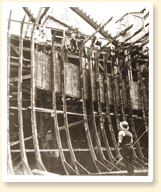

Ribs of the merchant ship Victoria Park at Pictou shipyards, Pictou, N.S., 1942
Photo : National Archives of Canada |
The War Economy and Controls: Shipping and Shipbuilding
After the fall of France in May 1940 ( see The Invasion of Western
Europe ), it became a priority to enlarge the ' merchant shipping
fleet, to replace ships lost, and to make sure that there were naval
escort vessels to guard convoys against German submarines.
Britain was highly vulnerable, and North American
arms and supplies were a lifeline. Canada in 1940 had just started to build patrol vessels for the
protection of its own coasts, but Britain soon placed orders for 26
ten-thousand-tonne cargo ships and soon after orders for naval
escorts and minesweepers. This was just the beginning, as Britain
made clear it needed Canada to build as many naval and merchant
ships as it possibly could. The practically non-existent Canadian
interwar shipbuilding industry - three shipyards employing fewer
than 4,000 men - expanded to 90 plants on the East and West Coasts,
the Great Lakes and even inland. More than 126,000 men and women
were employed. In all, the shipyards built 4,047 naval vessels, most
of them landing craft but including over 300 anti-submarine warships, among them 4 Tribal class destroyers, and 410 cargo
ships. At its wartime peak in September
1943, the industry was able to deliver the ten-thousand-tonne SS
Fort Romaine in a stunning 58 days from the start of construction. The government also formed Park Steamship Company, a Crown company,
to control the operation of its new, standardized cargo vessels. The
Park fleet of 176 vessels made 936 wartime voyages carrying
munitions and supplies all over the world. Related Newspaper Articles
English Articles
French Articles
-
Petits bâteaux de guerre
Le Devoir, 08/10/1941
-
Lancement de 8 navires de guerre
Le Devoir, 27/10/1941
-
Le lancement du 'Fort-Nipigon'
Le Devoir, 05/11/1941
-
Le lancement et bénédiction du 'Fort-Tadoussac'
Le Devoir, 06/11/1941
-
Nouveau chantier maritime à Montréal
Le Devoir, 07/01/1942
-
Nouveau destroyer canadien lancé outre-mer
Le Devoir, 21/07/1942
-
"Deux corvettes lancées, deux autres baptisée"
Le Devoir, 24/08/1942
-
Les chantiers maritime de la Colombie
Le Devoir, 10/09/1942
-
Chantier naval d'un million à Québec
Le Devoir, 11/09/1942
-
Nouvelles de guerre. $750 millions de commandes navales
Le Devoir, 15/09/1942
-
Revue de la situation navale
Le Devoir, 04/07/1944
-
"La "George-T. Davie" reprend la direction"
Le Devoir, 04/07/1944
-
Grève aux chantiers maritimes de Halifax
Le Devoir, 27/07/1944
-
Des cargo brésilien en construction au Canada
Le Devoir, 19/08/1944
-
Nouvelle frégate canadienne
Le Devoir, 05/09/1944
-
Nouveau navire lancé
Le Devoir, 19/09/1944
-
Record de nos chantiers maritimes
Le Devoir, 12/10/1944
-
Ces nouveaux transports lancés par "Vickers"
Le Devoir, 18/10/1944
-
Le 'Laetitia' sera sous peu en service comme navire-hôpital
Le Devoir, 02/11/1944
-
50e navire lancé à la 'Vickers'
Le Devoir, 07/11/1944
|